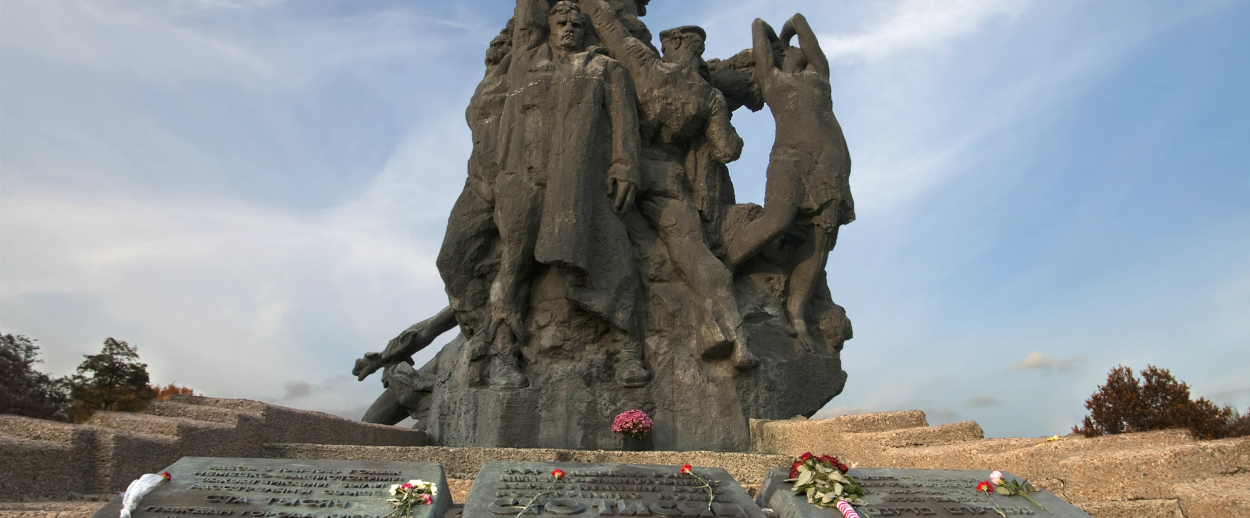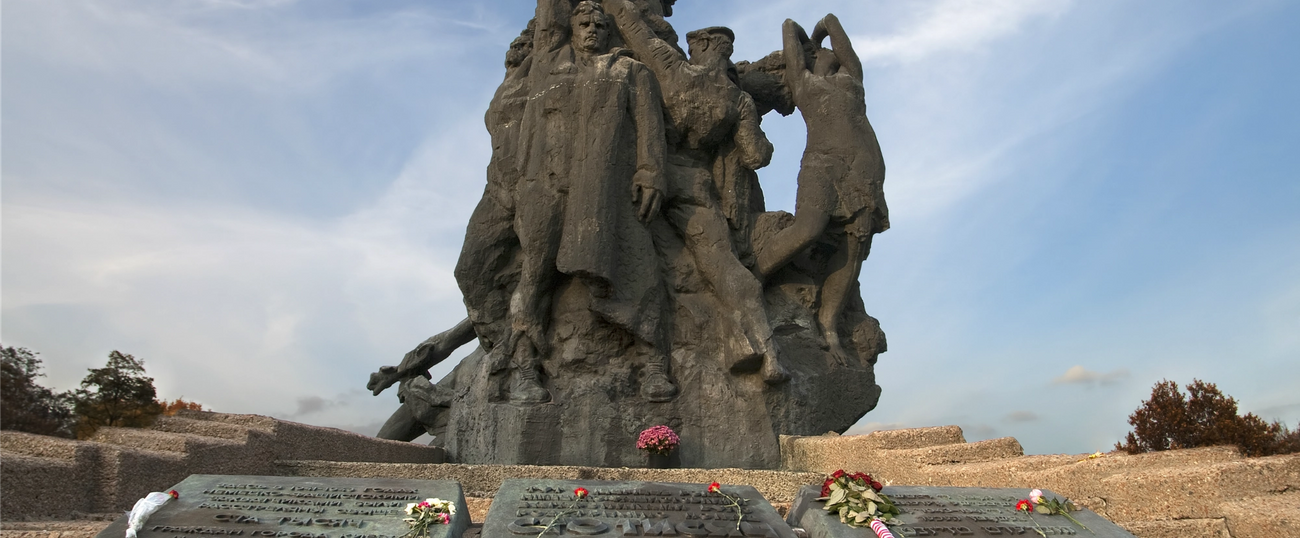Remembering Babi Yar
76 years after the single largest massacre of Jews in the Holocaust, the site continues to inspire acts of humanity and courage




From the late 1950s onwards, a small group of Soviet intellectuals began assembling annually at a site on the northern fringe of the Ukrainian capital, Kiev, that had become a pasture for cattle. Some would stand in solemn lament, while the Jews among them would join in hushed incantations, speaking the ancient prayer for the dead. The Soviet police would look on. If the group lingered for too long or began to arouse the interest of passersby, they would be dispersed. If they laid flowers, they would spend the next 15 days in jail.
On September 19, 1961, another Soviet intellectual, Yevgeny Yevtushenko, published a poem bearing the name of that site in the leading Soviet literary journal, Literaturnaya Gazeta. The poem was “Babi Yar.” It began with the words, “No monument stands over Babi Yar. A steep cliff only, like the rudest headstone.”
Twenty years before the publication of Yevtushenko’s poem, nearly to the day, Babi Yar was the scene of one of the darkest chapters in human history, an oft forgotten and deliberately obfuscated stanza in the chronicles of human barbarism.
On September 19, 1941, the city had been abandoned by the Soviet forces retreating under the lightning-fast advance of the German army. On the same day, Kommando 4a, an elite unit of the German Einsatzgruppen, the mobile death squads charged with exterminating Jews and other undesirables in captured territories, entered the city. On September 29 and 30, the squad, reinforced by Ukrainian police and volunteer Ukrainian nationalists who viewed the invading Germans as liberators from Soviet tyranny, carried out the massacre of 33,771 Jews at Babi Yar. By the end of the war, over 100,000 people, including Soviet partisans, Ukrainian nationalists (whose alliance with the Nazis was short-lived), residents of a nearby mental hospital, gypsies, Soviet sailors, and Dynamo Kiev footballers, were also shot at the site. But of the estimated 100,000 dead, 90,000 were Jews.
The initial two-day operation was the largest single massacre of Jews during the Holocaust, and took place a year before the Germans initiated the systematic mass killing of Jews by stationary gas chambers at three death camps in Poland—Belzec, Sobibor and Treblinka.
The gas chambers were introduced in large part to overcome the psychological fallout suffered by German soldiers from carrying out mass killings of Jewish civilians at places like Babi Yar. The killings in Kiev were not achieved through train schedules, distant camps, and sealed death chambers attended to by other prisoners. Kiev was the stuff of crying children snatched from the arms of their mothers and having their skulls dashed against brick walls. It was the wounded climbing out from the piles of corpses and layers of soil pleading with their executioners to finish them off with another bullet lest they suffocate to death.
In the two decades between the massacre and the publication of Yevtushenko’s poem, the official policy of the Soviet Union was to avoid mention of such massacres or else to deny their fundamental character as acts of genocide. Over 1.3 million Jews were killed in sites like Babi Yar throughout the Soviet Union. Most of the killing fields remain neglected and unmarked.
The Soviet authorities had good reason to deny the nature of these crimes. For one, an invading army freely hunting and massacring over a million civilians throughout the land made a mockery of supposed Soviet power. There was also the deeply uncomfortable reality that Ukrainians and other peoples cobbled together in the officially harmonious Soviet Union, had in many cases been willful participants in the killings of their fellow citizens.
By the 1950s, the Soviet Union had also become the foremost proponent of anti-Zionism, provided the Arabs with arms, and stood in visceral opposition to the State of Israel. Soviet propaganda denounced the Jews as “rootless cosmopolitans” and “bourgeois nationalists” for seeking a homeland of their own in no small part because of the failure of European states to prevent their wholesale slaughter.
Under Stalin and then Khruschev, antisemitism had become state policy. Restrictions on Jewish admission to universities were applied, show-trials of Jewish artists were staged, and a regular debasement of Jews in the official press created a pervasive culture of vulgar “street antisemitism” from the schoolyard to the trolleybus. In this context, the Soviet authorities had no desire to elicit sympathy for the Jews by fostering an understanding of the horrors that had befallen them just a short time ago.
Yet among the population of Kiev, there was no doubt as to what had occurred at Babi Yar or who the principle victims had been. A small, brave cultural elite in the Soviet Union dared to probe the matter further, determined to expose through the subtlety and majesty of art what no official record would admit.
The composer Dmitri Shostakovich was moved to set Yevtushenko’s poem to music. Upon reading the poem, he remarked to a friend, “I cannot not write it.” In his dictated memoirs, Shostakovich observed, “people knew about Babi Yar before the poem, but they were silent. But when they read the poem, the silence was broken.”
The sum of Yevtushenko’s words and Shostakovich’s music was Symphony No.13 (Babi Yar). It was first performed in Moscow on 18 December 1962 by the Moscow Philharmonic Orchestra.
But in a state where laying flowers at a killing field was seen as criminal subversion, a symphony by the most celebrated composer of the day, the lyrics of which chart the history of antisemitism from shows-trials and pogroms to Anne Frank, could not proceed without incident. The conductor was interrupted during final rehearsals with a request from the Minister of Culture to drop the offending first movement. He refused. The singer was then conveniently called up to perform at the Bolshoi. The TV broadcast was cut. Still the production proceeded at immense personal risk to everyone associated with it, not least Shostakovich himself.
Today, the denial of the massacre of the Jews through enforced silence has been replaced by simply drowning out the genocide through a preponderance of monuments and counter-monuments to each group affected by Babi Yar. This reflects the complexity of modern Ukraine and its discomfort with truly addressing how a community entirely assimilated into Soviet society could be plucked from its ordinary metropolitan existence and delivered to the hell of the ravine under the watch, and in part, by the hand, of their Ukrainian neighbors.
But art has an honesty that is difficult to suppress. Through it, two non-Jewish Soviet cultural titans, Yevgeny Yevtushenko and Dmitri Shostakovich forced a reckoning with the past that no Soviet censor or lurking party official could deny.
Shostakovich’s Symphony No.13 will be performed at Hamer Hall in Melbourne, Australia on Sunday, September 17.
Alex Ryvchin is a writer born in Kiev and the Director of Public Affairs at the Executive Council of Australian Jewry.